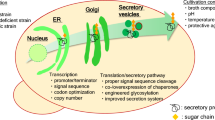Summary
The organism used wasSaccharomyces ellipsoideus. Exposure of yeast cells to a hypertonic strontium chloride generally does not establish typical plasmolysed cells. Rather, during a short period of exposure to plain hypertonic strontium chloride solution or to a hypertonic medium supplemented with high content of strontium chloride, the cell walls ruptured and subsequently the formation of spherical osmotically fragile bodies observed. Being associated with large droplet of protoplast together with the plasmolysed cells in the medium, abundantly small and numerous particles imperfectly for reliable counts to be made appear.
About other kinds of salts, the protoplast of the yeast cell used separated from the wall smoothly when plasmolysed with sodium chloride or potassium chloride. But calcium chloride increasingly produced the cell rupture. However subsequent successive growth of small particles of protoplast could not be observed in the medium containing calcium chloride. Despite similar results using manganese chloride or magnesium chloride, it seems to cause the damage of the sub cellular structure during prolonged incubation. Similar result was obtained, when the cells were treated in polyethyleneglycol solution.
After incubation into liquid strontium medium containing 2 mol strontium chloride, subcellular particles were isolated by the peculiar method (Fig. 6) and were incubated further. Such particles multiplicated, they being designated as K-fragment, and enlarged in size, and became K-body. The size of K-body was threefold as large as that of K-fragment. After further prolonged incubation K-body also enlarged in size, calling it K-cell. The protoplasm of K-cell was less well organized, but the early stage of the formation of daughter K-cell as revealed by microscopical observation beared resemblance to the budding found in mother yeast cell.
The findings considered in conjunction with our cytochemical studies of the action of solutions of RNase or DNase, or the stain with some basic dyes, have led us to the conclusion that macromolecular fragment and nuclear substance present in the K-fragment, K-body and K-cell, respectively. Regeneration will result in the most miniature feature of the yeas cell.
Similar content being viewed by others
Literatur
Eddy, A. A., 1959: Formation of aberrant cell walls and of spores by the growing yeast protoplast. Nature183, 1101.
Lederberg, J., 1956: Capabilities of bacterial protoplasts. In: Bacterial Anatomy. Symp. Soc. Gen. Microbiol.6, 127.
Mudrack, K., 1956: Experimentelle Untersuchungen an isolierten Chloroplasten. Protoplasma46, 556.
Nečas, O., 1956a: Regeneration of yeast cells from naked protoplastSaccharomyces cerevisiae. Nature179, 1252.
—, 1956b: Die Regeneration von Zellfragmenten bei Hefen. Biol. Zbl.75, 268.
—, 1960: The structure of the nuclei of growing naked yeast protoplasts. Folia Biol.6, 223.
Nagasaki, S., 1960: Biochemical studies on the yeast cell wall. Memor. Facul. Agr. Kochi Univ.8, 1.
Pirson, A., und G. Schaeffer, 1957: Osmotischer Wasserentzug und Plasmolyse mit Polyäthylenoxid. Protoplasma48, 215.
Strugger, S., 1931: Interzellulare Myelinfiguren und ähnliche Bildungen bei der reversiblen Entmischung des Protoplasmas. Protoplasma15, 90.
Takada, H., 1953: Protoplasmological studies on the yeast cell adapted to high osmotic environment. J. Inst. Polytechn. Osaka City Univ.D 4, 17.
—, and S. Tokuno, 1958: Effect of ions and ribonuclease on the pyronine uptake by the yeast cell adapted to sodium chloride. J. Inst. Polytechn. Osaka City Univ.D 9, 27.
—, and B. T. Yamamoto, 1960: The isolation and the regeneration of cell fragment of yeast in hypertonic medium with strontium chloride. J. Inst. Polytechn. Osaka City Univ.D 11, 33.
Author information
Authors and Affiliations
Additional information
Herrn Prof. Dr. Karl Höfler zu seinem 70. Geburtstag in Verehrung gewidmet.
Rights and permissions
About this article
Cite this article
Takada, H., Yamamoto, B.T. Regeneration fragmentierter, nackter Protoplasten in Hefezellen. Protoplasma 57, 730–741 (1963). https://doi.org/10.1007/BF01252086
Received:
Issue Date:
DOI: https://doi.org/10.1007/BF01252086




